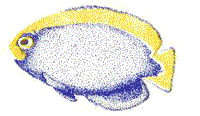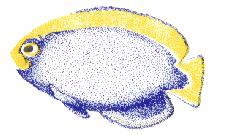|
The Majestic Lionfish
By Jim Wolf, Marine Biologist
Lionfish are perhaps one of the most dramatic and symbolic
of all salt water fishes. Their graceful flowing fins, slow deliberate
movements, and poisonous spines seem to embody many of the attractive and
mysterious features of the sea.
Lionfish and their relatives belong to a group of fishes
known as the scorpaeniformes. They are usually spiny (possibly venomous)
and have many small fleshy or bony protuberances on their face. As a group,
they are all predators that thrive on a diet of small fishes and crustaceans.
They usually will only eat live foods, but can be trained to eat prepared
foods (but be sure to use tongs, as they are potentially deadly!) It is
good idea to only feed them every 3-4 days. These fish are predators and
their digestive tract does not take kindly to daily additions of food.
There are two families of "lionfish" that are common to
the hobby.
Family Synanceiidae. These are the highly venomous stonefish.
Perhaps the most deadly fish in the sea, so caution is a must. The will
only bother things that they can eat, and enjoy eating live fish or crustaceans
every 3-4 days. They are common throughout the Indo-Pacific, and can attain
a length of 1 foot.
A word of caution... ALWAYS know exactly where they are
before servicing your aquarium, as they resemble stones, and may surprise
you.
Family Scorpaenidae. There are over 330 species of live
bearing fish in this cosmopolitan family that includes the 50 plus species
of rockfish found off the coast of California. The dorsal, anal and pelvic
spines are all venomous. Despite this, some fish may pick on their long
flowing fins, so watch for signs of aggression. Four species occasionally
find their way into the fish store:
Pterois and Dendrochirus are the large and dwarf lions
respectively (although the genera does vary). The black and red lions are
the larger species and can attain lengths of up to a foot, and have a fin
span of up to 18 inches. They are quite hardy, just remember to starve
them occasionally and feed them whole food with some variety (shrimp, fish,
squid etc.). The dwarf lions are more numerous and range from hardy species
to some that are quite delicate. Look for hardy specimens that are interested
in eating. (Do not let them actually eat prior to taking them home, since
they may vomit in the bag and foul the water!) Dwarf lions are a bit less
aggressive, and are sometimes finicky, so pick unaggressive tankmates and
tempt them with live food.
Radiata sp. and Antennata sp. and Fu Man Chu lions ( Dendrochirus
biocellatus) are more delicate than the other generic dwarf lions, but
all lions are well worth the effort. There are two other fish in the same
family that deserve a quick word. Goosefish and sea goblins (Rhinopias)
are exotic fringed fishes that frequently rest upon the bottom. Leaf-fish
anglers (Taenianotus) are small flattened fish that rely on camouflage
to capture their prey. Both fishes are unlikely to chase prey as they will
wait for it to come into range. Take time to insure that they get their
share, and try to place them into a tank with other slow feeding less aggressive
tankmates.
Editors Note, when cleaning a tank with Lionfish in
it, ALWAYS KNOW WHERE THE FISH IS ! Most hobbyists get stung because they
were not paying attention. Should you be stung by a lion Fish, immerse
the wound in as hot a water as you can tolerate. The heat helps break the
bond between the venom and the proteins in the blood. A Lion Fish sting
is similar to a Bee sting, and subseptability is dependent on your bodies
reaction to the venom. Expect the sting to create a serious discomfort
for one to three days, should it continue beyond that, or become intolerable
visit your local doctor immediately !
|











